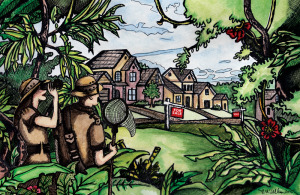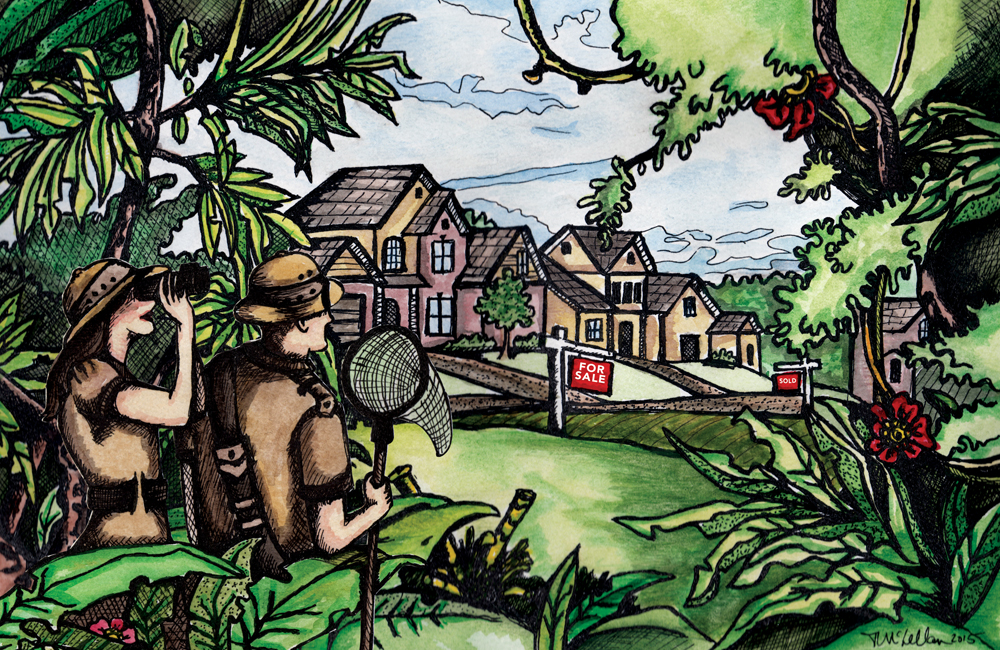10 tips for pricing your home to sell
stories by Janet Lees ❧ illustration by Tara McLellan
Setting a price for your home can be the most difficult and disheartening aspect of the whole selling process. Sherry Rioux of Clairwood Realty in Collingwood has some helpful guidelines to price your home to sell.
1. Think Like A Buyer
Sentimental value and memories often get in the way of realistic pricing. “If you think like a buyer, those memories or the fact that your late Uncle Ed built that kitchen for you, will not come into play,” notes Rioux. “Put yourself in the buyer’s shoes and picture visiting seven to 10 homes and having to make a decision. What things will impact your decision? Chances are it will be the same for your buyer.”
Choose your “big, round number price” that represents the value of your home, then price just below it. There is a psychology behind setting the right price, and if you want $500,000 for your home, list at $499,500. “This creates an image of a ‘deal’ for the buyer, who may be looking in that under-$500,000 price range.”
2. Use a Local, Licensed Realtor
“No one knows the market better than a local realtor,” says Rioux. “They are aware of the factors that will influence your price, like local market conditions, sales data, development charges, wells and septic operation and environmental regulations, for example.” Realtors also have full access for local MLS data and will be able to give you factual information about what is happening in your neighbourhood, “not just hearsay of what Fred down the street got for his home; they will know why a particular property received the price it did, and why another did not,” says Rioux.
3. Know The Market
While it’s helpful to know what is happening nationally on the real estate front, it’s more important to know your neighbourhood. What were local houses selling for a year ago, six months ago and a few weeks ago? “Comparable sales information is vital, as buyers will ask their realtor what the other properties in the neighbour went for,” says Rioux. “If your pricing is not in line, there needs to be a reason.”
This can be tricky if your home is the first in your neighbourhood to be resold. “I have experienced homes on the market for a very long time,” says Rioux. “The problem was not that the home wasn’t worth what they were asking; it was a problem of being the first newer home in that changing neighbourhood to go on resale. There were no comparables and buyers were wary of the price. We had to get them into the property so they could see that the value was there.” Also be aware of any foreclosures in your neighbourhood. One foreclosure probably won’t make a difference when you price your home, but if you are in a neighbourhood of several foreclosures, this can affect your list price if you want to be able to compete.
4. Get an Appraisal
An appraiser is an impartial professional who has an unbiased eye and uses facts and comparables to determine the value of a home. Appraisals have different purposes, depending on why it is being done. A bank appraisal for refinancing is different than an appraisal for insurance purposes. Be sure to clearly state to your appraiser the purpose of your request. “An appraiser, like a realtor, can also make suggestions to you as to what items you might want to consider improving, which may raise the value of your home before going to market,” notes Rioux.
5. Price Ahead of the Curve
Picture this scenario: prices are dropping in your local market. Your home is priced for today’s market. But two months from now, when you’re starting to panic because your home has not sold, your house will be overpriced. You’re behind the curve. “At that point, if you drop to market value, you’ll be behind the curve again as prices are falling below your feet,” explains Rioux, “and constantly reducing the price may leave buyers wondering what’s wrong with the house.”
The chase to the bottom – continually lowering the price to catch up with the market – can be avoided if you look to the future and price your house accordingly. Rioux’s advice: in a market declining by one per cent per month, take three percent off your fair price to make your price competitive three months from now.
If you are in an increasing market, however, the same rule does not apply, warns Rioux. “If you overprice your house, listing it at what you think it will be worth three months in the future, you will have missed the immediate interest that a home gets when it comes out as a new listing. By the time your price is competitive, your house will most likely have been on the market too long and will now be a stale listing.”
6. Create a Fair Price
You now have the information to set a price for your home. “One way to get started is to choose an extremely low price and an extremely high price, then use the information you gathered to move up or down your scale,” suggests Rioux. “Once you have set the price, write it down. If you are honest and have done your homework, this will be your emotional baseline. Anything you get above it will be a bonus. And if you end up selling below your baseline price, it might be the market’s fault or it could be your fault. It all depends how honest you are with yourself and if you removed the sentimental ‘value’ you were placing on your property.” Remember, the “fair price” is only a starting point. There are scenarios where a buyer might be willing to overpay slightly for your house, and there are other reasons you might need to under price it. Consider all of the factors before setting your final price.
7. Make Your Price Attractive
With so much competition out there, you may want to think of what you can do to “sweeten” the deal. Should you include some furniture? What about that boat in the driveway? Would a long closing or rent-to-own option be of interest? “And don’t forget, a vendor take-back mortgage can often be very enticing to someone who doesn’t want to work with a traditional lending institution,” notes Rioux.
8. Stage Your Home To Sell
Your home doesn’t have to look like it is on the showroom floor of a furniture store, but it does need to be clean, tidy and inviting. “Pricing a home that makes people want to move in is a lot easier than adjusting your price for all the little pitfalls,” says Rioux. “You don’t have to live in the Taj Mahal to have your home show like a palace.” Neutral colours, cleared countertops, limited family photos and lack of clutter are just a few suggestions to get you started. “When a home shows like a million bucks, it can be easier to justify the price in a competitive market,” says Rioux.
9. Be Ready To Go To Market
When you set a fair price, it should take into consideration the condition of your home and how it relates to the surrounding homes. “For example, if all the homes in your neighbourhood have granite counters, then this would be an expectation when potential buyers see your price, says Rioux. “But if you have done some improvements that aren’t the norm, like back-up generators, radiant heated floors, etc., these can add value to your home.” Buyers will expect that all mechanical items, fixtures, etc. are in good working condition. If you want to get top dollar for your home, be sure your home is ready: paint and flooring in good condition, landscaping well maintained, spaces uncluttered, etc. Any damages to the home should be repaired (and disclosed). “By doing all the little touch-ups that you hadn’t gotten around to before, you can be setting yourself up to get as close to asking as possible,” says Rioux. Don’t give a buyer a reason to lower the price.
10. Market Your Home
No matter what the price, you can’t be successful if you don’t market your property. This involves getting your home “out there.”
“Those clients who say they don’t want a sign on their lawn and they don’t want their neighbours to know, are tying the hands of the person they are paying to get a job done,” says Rioux. She recommends using a variety of techniques, from open houses to print advertising, social media, video tours and top-notch photography.
“Statistics have taught us that 85 per cent of all buyers start their search online, so if you don’t have professional photography done of your home, you are doing yourself an injustice,” says Rioux, adding, “I like to have floor plans included to complement my listings so that serious prospective buyers can contemplate placing their own furniture.” At any one time there are thousands of listings on the market; you need to make your home stand out above the rest.















